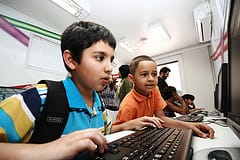The remarkable spread of free online courses through American higher education has prompted major soul-searching and some fast footwork among traditional universities and their national organizations.
 The next step: K-12 MOOCs provided by topflight schools to students beyond their own campuses. Photo by poperotico via photopin cc |
You can already find “MOOCs” (massive open online courses) on a host of websites, created and delivered by a wide array of institutions and individuals.
As I write, Coursera offers 207 courses, ranging from astronomy to public health, presented by professors at such upscale schools as CalTech, Duke, and Stanford (where, as best I can tell, all this originated—and just a few years ago). Udacity offers about twenty courses, EdX (founded by Harvard and MIT) around ten.
Providers such as these are proliferating and expanding via a hodgepodge of for- and non-profit organizations with offerings that range from free to pricey. And participation is soaring, too. Coursera claims two million course-takers worldwide—and since the courses are online, one can indeed take them anyplace, anytime.
This remarkably rapid development carries huge potential for universalizing and customizing higher education and for enormous cost savings. But it collides with age-old traditions and deeply entrenched practices regarding how one earns a college degree—and it also carries enormous risks. Who determines which students “pass” these on-line courses and what’s the evidence that they met a suitable standard of accomplishment? By what process will “credit” be assessed and assigned and how will degrees be awarded, by whom and for an accumulation of what?
A host of lesser questions arises, too, such as what’s the meaning of an online course in science that affords students no access to or experience in laboratory settings, or in art, music, and myriad “applied” subjects that cannot be fully mastered on a computer screen?
To sort some of this out, the Gates Foundation, Coursera and the American Council on Education (ACE) recently teamed up to evaluate what students deserve what sorts of “credit” for which kinds of coursework done via Coursera. The ACE already operates a “College Credit Recommendation Service” that analyzes “workplace learning” and other courses taken outside traditional postsecondary institutions and recommends to colleges which of these should count for how much of what sort of degree credit. It’s now headed toward something of the sort for MOOCs.
Which got me thinking: Why not MOOCs in K–12 education, too—for the kids, not just their teachers? Why is this not another form of on-line or blended learning with huge potential to foster equity, acceleration, individualization, choice, and much else that we prize in the elementary-secondary sector?
We already have virtual charter schools in many places and several state-provided counterparts such as the Florida Virtual School. We have online providers of specific courses (see Apex Learning, for example). Home-schoolers can access multiple options. And we have more and more schools seeking to blend on-line offerings into their brick-and-mortar classrooms.
What we don’t yet have, as far as I know, are K–12 MOOCs provided by topflight schools to students beyond their own campuses. Imagine “History at Andover,” “Pre-calculus at Dalton,” “English literature at New Trier,” “Physics at Bronx Science.” Imagine middle school health courses provided by public-health professors at Johns Hopkins or experts at the Centers for Disease Control, art classes from the Metropolitan Museum, virtual field trips to the Galapagos with the National Geographic. There’s really no limit.
I’m sure that advanced high school students around the U.S. are already availing themselves of postsecondary MOOCs. That’s really just another form of dual enrollment. But will their high schools give them credit? And if Lawrenceville Academy were to offer a nifty high-school level MOOC in, say, world geography, by what means would Bill or Belinda, students at Bethesda-Chevy Chase High School, get credit for taking it? Yes, this could easily be managed if their school brings it “in-house,” much like an APEX course. But what if they take it outside school and then want credit toward their diploma from Montgomery County? And why shouldn’t this be possible? Ditto for the drop-out who now has a day job (or a baby) but wants to resume the accumulation of high-school credit.
Think about the reverse, too. What if a kid enrolled at pricey Sidwell Friends takes an advanced-algebra “MOOC” over the summer? It doesn’t much matter whether the course originates at MIT, Stuyvesant High School, or Singapore’s Raffles Institution. The question is whether Sidwell will give that student credit—and then give her parents a tuition reduction or shorten the time she must spend there en route to a diploma?
All of this is much easier to visualize at the high school level, of course, and undeniably more complicated with eight-year-olds. But the concept isn’t really very different. Even in the primary and middle grades, MOOCs offer potential for gifted/talented pupils, for some kids with disabilities (particularly the physical and social kind), and for specialized or hard-to-teach subjects (e.g., learning Japanese with the help of a native speaker of that language). Youngsters in rural communities might especially benefit from access via technology to courses that their schools can’t offer. So would kids living in remote places or accompanying their parents to other parts of the planet.
But must the school remain in charge of all this, or can individual pupils and families access MOOCs for which they then get credit, whether that means credit to pass from fourth to fifth grade or to graduate from high school with an honors diploma? For the latter to work, someone must “validate” that the credit is duly earned and deserves to “count.” School systems or states might do this on their own, of course, but that would lead to uneven expectations and a lot of duplicative work. What about something akin to the ACE-Gates-Coursera initiative for K–12 education? Where are you, funders and visionaries, when we need you?
